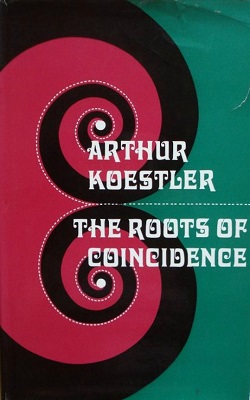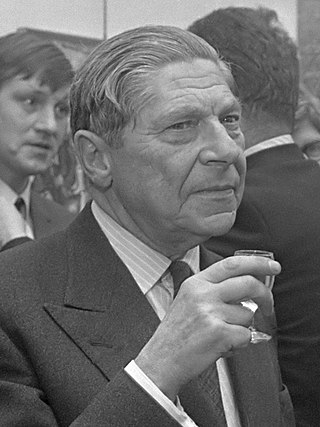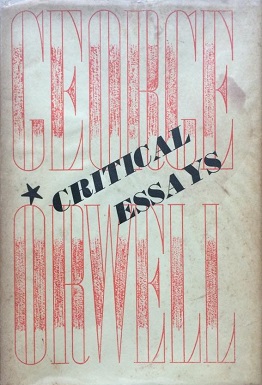
Color or colour is the visual perception based on the electromagnetic spectrum. Though color is not an inherent property of matter, color perception is related to an object's light absorption, reflection, emission spectra and interference. For most humans, colors are perceived in the visible light spectrum with three types of cone cells (trichromacy). Other animals may have a different number of cone cell types or have eyes sensitive to different wavelength, such as bees that can distinguish ultraviolet, and thus have a different color sensitivity range. Animal perception of color originates from different light wavelength or spectral sensitivity in cone cell types, which is then processed by the brain.

Eric Arthur Blair, better known by his pen name George Orwell, was an English novelist, essayist, journalist, and critic. His work is characterised by lucid prose, social criticism, opposition to totalitarianism, and support of democratic socialism.

The visible spectrum is the band of the electromagnetic spectrum that is visible to the human eye. Electromagnetic radiation in this range of wavelengths is called visible light. The optical spectrum is sometimes considered to be the same as the visible spectrum, but some authors define the term more broadly, to include the ultraviolet and infrared parts of the electromagnetic spectrum as well.
A holon is something that is simultaneously a whole in and of itself, as well as a part of a larger whole. In other words, holons can be understood as the constituent part–wholes of a hierarchy. Holons are sometimes discussed in the context of self-organizing holarchic open (SOHO) systems.

Darkness at Noon is a novel by Hungarian-born novelist Arthur Koestler, first published in 1940. His best known work, it is the tale of Rubashov, an Old Bolshevik who is arrested, imprisoned, and tried for treason against the government that he helped to create.

The Sleepwalkers: A History of Man's Changing Vision of the Universe is a 1959 book by Arthur Koestler. It traces the history of Western cosmology from ancient Mesopotamia to Isaac Newton. He suggests that discoveries in science arise through a process akin to sleepwalking. Not that they arise by chance, but rather that scientists are neither fully aware of what guides their research, nor are they fully aware of the implications of what they discover.

Theory of Colours is a book by Johann Wolfgang von Goethe about the poet's views on the nature of colours and how they are perceived by humans. It was published in German in 1810 and in English in 1840. The book contains detailed descriptions of phenomena such as coloured shadows, refraction, and chromatic aberration. The book is a successor to two short essays titled "Contributions to Optics".

The Call-Girls: A Tragi-Comedy with Prologue and Epilogue is a novel (ISBN 0-09-112550-2) by Arthur Koestler. It was published in October 1972 and its plot tells the story of a group of academic scientists struggling to understand the human tendency towards self-destruction, while the group members gradually become more suspicious and aggressive towards each other.

Paul Kammerer was an Austrian biologist who studied and advocated Lamarckism, the theory that organisms may pass to their offspring characteristics acquired in their lifetime, meaning variation would be directed towards creating adaptations.

The Thirteenth Tribe is a 1976 book by Arthur Koestler advocating the Khazar hypothesis of Ashkenazi ancestry, the thesis that Ashkenazi Jews are not descended from the historical Israelites of antiquity, but from Khazars, a Turkic people. Koestler hypothesized that the Khazars migrated westwards into Eastern Europe in the 12th and 13th centuries when the Khazar Empire was collapsing.

The Roots of Coincidence is a 1972 book by Arthur Koestler. It is an introduction to theories of parapsychology, including extrasensory perception and psychokinesis. Koestler postulates links between modern physics, their interaction with time and paranormal phenomena. It is influenced by Carl Jung's concept of synchronicity and the seriality of Paul Kammerer.

The emission spectrum of atomic hydrogen has been divided into a number of spectral series, with wavelengths given by the Rydberg formula. These observed spectral lines are due to the electron making transitions between two energy levels in an atom. The classification of the series by the Rydberg formula was important in the development of quantum mechanics. The spectral series are important in astronomical spectroscopy for detecting the presence of hydrogen and calculating red shifts.

Hyperspectral imaging collects and processes information from across the electromagnetic spectrum. The goal of hyperspectral imaging is to obtain the spectrum for each pixel in the image of a scene, with the purpose of finding objects, identifying materials, or detecting processes. There are three general types of spectral imagers. There are push broom scanners and the related whisk broom scanners, which read images over time, band sequential scanners, which acquire images of an area at different wavelengths, and snapshot hyperspectral imagers, which uses a staring array to generate an image in an instant.
Lumpenbourgeoisie is a term used in colonial sociology to describe members of the middle class and upper class who have little collective self-awareness or economic base and who support the colonial masters. It is often attributed to Andre Gunder Frank in 1972, although the term is already present in several texts by Lukács (1943), Koestler (1945), C. Wright Mills (1951) and also in Paul Baran's The Political Economy of Growth (1957). Nonetheless, the term was popularized by Frank's book Lumpenbourgeoisie and Lumpendevelopment: Dependency, Class and Politics in Latin America (1972) which used it in its title.

Arthur Koestler, was a Hungarian-born author and journalist. Koestler was born in Budapest and, apart from his early school years, was educated in Austria. In 1931, Koestler joined the Communist Party of Germany, but he resigned in 1938 after becoming disillusioned with Stalinism.
In 1949, shortly before he died, the English author George Orwell prepared a list of notable writers and other people he considered to be unsuitable as possible writers for the anti-communist propaganda activities of the Information Research Department, a secret propaganda organisation of the British state under the Foreign Office. A copy of the list was published in The Guardian in 2003 and the original was released by the Foreign Office soon after.

Living with Koestler: Mamaine Koestler's Letters 1945–51 is a book about the author Arthur Koestler and Mamaine Paget, Koestler's second wife. More specifically, it is a selected compilation of Mamaine's letters to her twin sister Celia about her life with Koestler. The spontaneous and engaging letters reflect the intensity of her life with Koestler between 1945 and 1951.

Frank Graham Sr. was an American sportswriter and biographer. He covered sports in New York for the New York Sun from 1915 to 1943 and for the New York Journal-American from 1945 to 1965. He was also a successful author, writing biographies of politician Al Smith and athletes Lou Gehrig and John McGraw, as well as histories of the New York Yankees, New York Giants and Brooklyn Dodgers. Graham's writing style was notable for his use of lengthy passages of "unrelieved dialogue" in developing portraits of the persons about whom he wrote. Graham was posthumously honored by the Baseball Writers' Association of America with the J. G. Taylor Spink Award in 1971, and by the Boxing Writers Association of America with the A. J. Liebling Award in 1997, the highest award bestowed by each organization.
The Case of the Anti-Soviet "Bloc of Rightists and Trotskyites", also known as the Trial of the Twenty-One, was the last of the three public Moscow trials charging prominent Bolsheviks with espionage and treason. The Trial of the Twenty-One took place in Moscow in March 1938, towards the end of the Soviet Great Purge.

Critical Essays (1946) is a collection of wartime pieces by George Orwell. It covers a variety of topics in English literature, and also includes some pioneering studies of popular culture. It was acclaimed by critics, and Orwell himself thought it one of his most important books.















